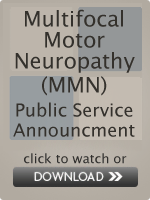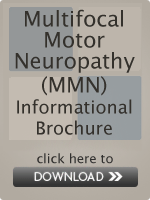

MMN Signs and Symptoms
By definition MMN causes weakness. There is essentially no numbness or tingling, and pain is not a significant factor. MMN usually develops asymmetrically and tends to begin in the hands. Frequently, the weakness can be recognized as fitting a specific nerve territory. For example, someone who develops a wrist and finger drop has a problem in the radial nerve, and when new weakness occurs, a different nerve is likely to be involved. The attack on multiple single nerves is called a multiple mononeuropathy syndrome. This pattern can be seen in other diseases, but MMN is the only condition where the attack is isolated to the motor nerve fibers. It follows that this is the most important clinical finding to diagnose MMN.
Patients with MMN can have other symptoms including twitching, or small random dimpling of the muscle which neurologists call fasciculations. Fasciculations are the spontaneous firing of a motor unit (the collection of all the muscle fibers that are innervated by a single motor neuron). Fasciculations are also characteristic of ALS (Amyotrophic lateral sclerosis) and this is one reason many patients with MMN are initially misdiagnosed with ALS. Other lower motor neuron signs such as atrophy, decreased tone and absent reflexes occur in both diseases, although in MMN these tend to affect the territories of single nerves, while in ALS they affect all of the muscles in the limb. In contrast to MMN, patients with ALS may have “upper motor neuron signs” (UMN) caused by damage to motor control in the brain. These signs include increased muscle tone and reflexes and pathologic reflexes such as a Babinski sign.


